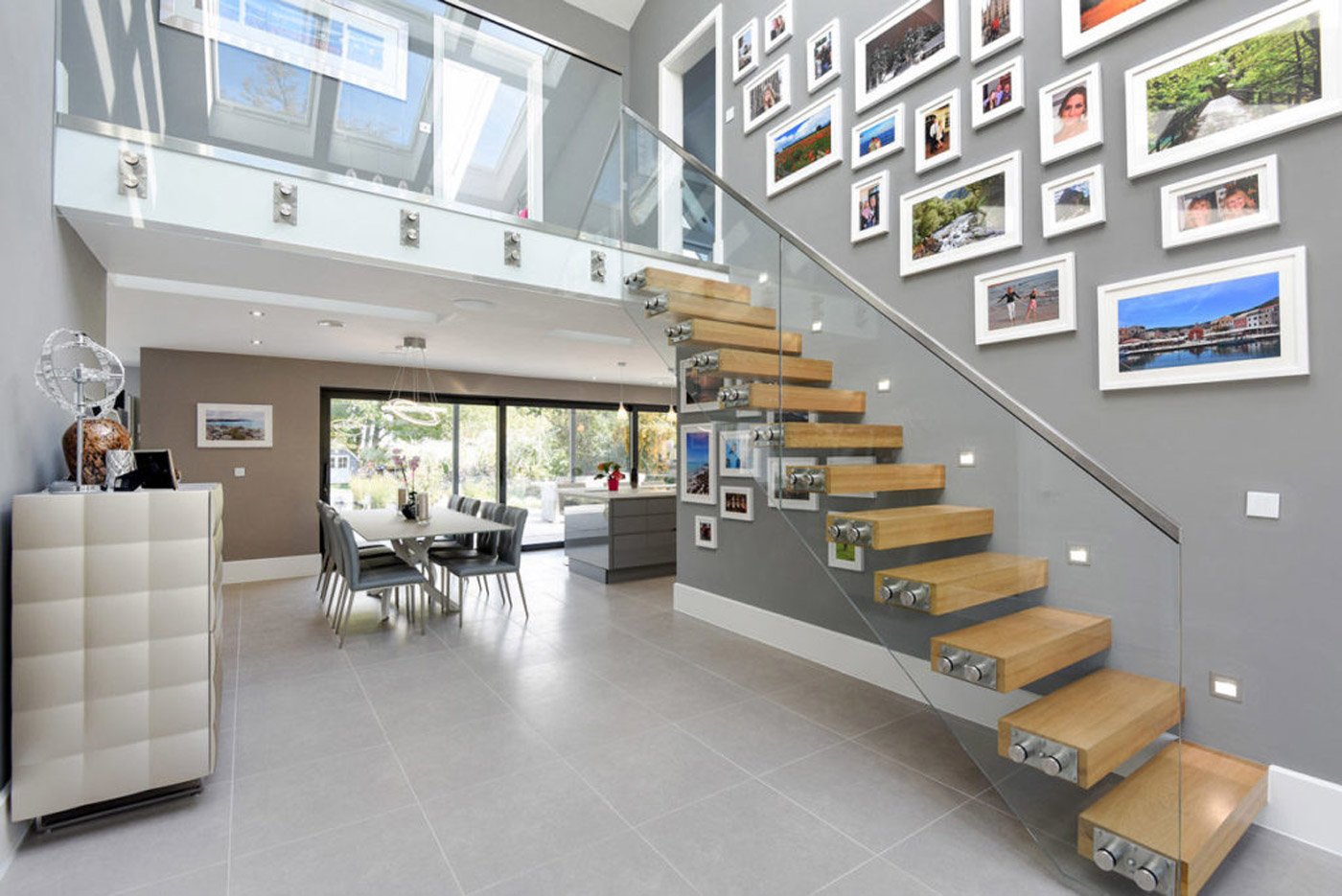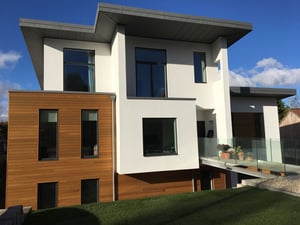Passivhaus is a building standard that has gained a lot of traction in recent years. So much so that it is in danger of becoming a convenient peg to hang your “eco” hat on. The standard was developed by Bo Adamson and Dr Wolfgang Feist in Darmstadt, Germany in 1991. It uses rigorous attention to insulation and air-tightness detail to reduce space heating demands to the lowest practically possible level.
The ‘Passiv’ part of Passivhaus means that the building can be heated (mainly) by the activity within the building – people and pets living in the house, cooking, boiling the kettle, etc. – and by passive solar heat so that no active form of heating is needed.
The Passivhaus Institute accepts that some heating will be needed in the coldest times but that this can be as low as 10W of heat per m2 of floor area. Similar rules apply to cooling, with shade being designed in, windows positioned to provide cross-ventilation and, in some cases, cooler night-time air used to purge the house of excess heat.
In case you missed the previous articles of the Eco Series with Tim, here they are:
To get a Passivhaus certificate the builder has to go a little bit further than that. They have to meet two basic standards:
1. Energy demand for space heating (as above) must not exceed 15kWh/m2/yr. The Passivhaus standard provides all sorts of guidance on how to achieve this; the materials and methods that need to be used, but fundamentally it comes down to insulation and almost hermetically-sealed air-tightness.
2. 120kWh/m2/yr primary energy demand. This covers ALL the energy demands of the house and relates to the amount of fuel that is used (either directly or via a power station) to meet those energy demands. It is a bit of a grey area in the standard but generally, renewable energy produced on site is not counted in the calculations. This means that a renewable energy system on site producing hot water or electricity will enable the property to meet this standard.
 What this shows is that Passivhaus is all about energy. About reducing the energy demands of the building to their practical, absolute minimum. Which is, it has to be said, a fine aspiration. But is it the only, or even most important, aspiration?
What this shows is that Passivhaus is all about energy. About reducing the energy demands of the building to their practical, absolute minimum. Which is, it has to be said, a fine aspiration. But is it the only, or even most important, aspiration?
In 1991, when the standard was first launched, coal-fired power stations were the norm (especially in Germany), grid-available renewable energy was virtually non-existent and the impact of climate change was just beginning to bite. Any effort that reduced our demand for fossil fuel based energy was a good idea and it was that and the climate – both economic and meteorological – in Germany that gave Passivhaus its early traction.
There are two issues for the UK self-builder to consider before embarking on a Passivhaus project:
1. The UK has a different climate to Germany. We do not generally have such long, cold winters as are usual in Germany. That is not to say that we should not build thermally efficient houses but that very high levels of insulation and airtightness mean using more materials. Every kg of any material carries its own embodied CO2 burden. Using less material also reduces CO2 emissions.
2. The UK has just 7 coal-fired power stations left. They produce just 2% of our energy. In the last year (2017/18) we produced almost as much energy from renewable sources as we did from gas-fired power stations.

In the 30 years since Bo Adamson and Dr Wolfgang Feist began thinking about this, the game has changed. Reducing energy demand is still a good idea but focusing solely on energy may no longer be the best idea.
HOW TO ACHIEVE PASSIVHAUS
The UK building regulations set less arduous standards than Passivhaus that result in a heating demand of 55kWh/m2floor area per year and give little consideration to primary energy demand. If you want a Passivhaus then you will need insulation, airtightness and lots, and lots of attention to detail. It is similar to a ‘fabric-first’ approach to construction but differs in the strict limits on the amount of energy that can be used.
This is achieved with U-values for walls, floor and roof of 0.15W/m2, windows and doors 0.8W/m2and airtightness of 0.6m3/hr. A more detailed explanation is available at www.passivhaus.org.uk/standard.jsp?id=18 but this covers the main points.
In terms of space heating demand, airtightness is the key issue. It will affect decisions on the construction method as it is easier to achieve high levels of airtightness with SIPS, for instance, than it is with brick-and-block. It will mean spending time, effort and money on the detail around things like how windows and doors are installed, which windows and doors to use, letter boxes, key holes, pipe and cable penetrations. And on testing to ensure that the right level of airtightness has been achieved.
But Passivhaus goes further than just space heating energy demand. While there is no strict limit on hot water consumption, for instance, the designer will have to take it into account as it is also an energy user. This then generally means using low-flow showers, aerated taps, and the like to limit the amount of hot water than needs to be produced. It is this primary energy limit that means consideration has to be given to these supplementary issues.

WHAT IS THE COST BENEFIT?
The benefit is fairly clear – a significant reduction in running costs. A 200m2house built to building regulations standard will need 11,000kWh of energy for space heating. Assuming a new condensing gas boiler that will cost around £600 per year. Building regulations require some consideration be given to overheating, so the cooling demand could be the same as for a Passivhaus.
It could also use the same LED lights and high-efficiency appliances. The “average” UK household of this sort of size, with four people living in it, will use around 6,500kWh of electricity per year and around 3,000kWh on hot water. The overall running cost for the “average” house is then likely to be around £1,800 per year.
The 200m2 Passivhaus, with a demand of only 15kWh/m2/yr will only need 3,000kWh for space heating and it is safe to assume that at least half that will be provided by activity in the house and passive solar gain. The heating bill will then be around £90 per year and the overall running cost could fall to around £975.
The cost of a Passivhaus is a bit more tricky. Estimates for the extra cost vary from 10% to 25% of the build cost, which is affected to a large extent by whether certification is wanted. Passipedia (a website dedicated to Passivhaus) conducted a detailed analysis of the build of a 149m2house built in Germany in 2015. It concluded that extra cost was 14,000 euro and the net saving in running cost 585 euro per year, which includes the extra mortgage cost from the higher build cost.
It is possible to find other studies that give quite different figures, from a ‘profit’ of upwards of £100,000 over the life of the house to an extra investment of over 30% of the build cost. The reality may be that the extra cost is a factor of the size of the development (an estate of Passivhaus houses will cost less per house than a single house) and the quality of the house being built. A high-quality house with a build cost of over £2,000/m2 will have a lower proportional extra cost that a lower quality house.
Around 35% of the extra cost will be in meeting the Passivhaus glazing standard – windows and doors, of necessity all top quality, airtight, triple-glazed. Another 30% will be spent on achieving the required airtightness. The balance will be spread across insulation, mechanical ventilation, shading, and design costs.
Bear in mind that the Passivhaus standard was developed in a part of the world that has relatively long, cold winters, where the temperature difference, indoors to outdoors, will be quite high. The UK average winter temperature is 70C and temperatures below zero are rare – average is less than 5 days per year. In Germany, the average winter temperature is 30C with extremes of -100C occurring most years.
Backing off on glazing and airtightness can make a big difference, with the potential to save up to 50% of the investment. With thought and care it is entirely possible to achieve a space heating demand of 25kWh/m2/yr for an extra cost of 8% to 10%. For our 200m2 house that means an energy demand of 5,000kWh and a space heating running cost of around £250 per year.

CONCLUSION
We have come to expect continuously rising energy bills and anything that offers an alternative will always be attractive. As a result, the idea of thermally efficient, fabric-first construction is gaining a lot of traction, due in no small part to the influence of the Passivhaus standard. It can be argued that the rarity of weather extremes in the UK do not warrant all that investment, and it has to be recognised that ‘Passivhaus standard’ items like windows and doors are priced at a level attractive only to the manufacturer.
But there are savings to be made in tweaking the standard to suit the UK climate, which is where fabric-first starts. The purist may argue that driving the energy demand of the house to the lowest level is good for the homeowner and good for the planet. But this rather steps over the tight focus Passivhaus has on energy consumption. It raises the question of whether it is better for the homeowner and the planet to use a super-insulated, airtight door imported from Germany or a door of a slightly lower standard manufactured by a local company?
The pragmatist might argue might argue that ours is a warm, wet maritime climate, that renewable energy is now relatively cheap and widely available, and not troubling the power station more than we have to is also good for the homeowner and the planet.
We would like to thank Tim for sharing his expertise on our blog. If you would like to learn more about the Passive House Standard, check out our Self Build Blog!





